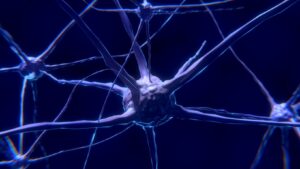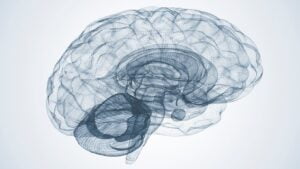Are your migraines more than just headaches? Do you feel dizzy, see double, or even lose your balance before the pain begins? These signs could point to something much more specific, a basilar artery migraine. While it’s rare, it’s serious, and often confused with a stroke or seizure.
In this blog, we will explain what a basilar artery migraine really is, why it happens, what symptoms you should look for, how it differs from regular migraines, and most importantly, when you need to see a neurologist for migraines.
Key Takeaways:
- Basilar artery migraines originate in the brainstem and are characterized by aura symptoms.
- Symptoms can include vertigo, difficulty speaking, impaired hearing, double vision, and loss of muscle control.
- Basilar migraines are more common in females and can last anywhere from 4 to 72 hours.
- Triggers for basilar migraines include stress, alcohol, lack of sleep, hormonal changes, and certain foods.
- Seek medical attention for proper diagnosis and management of basilar artery migraines.
Table of Contents
ToggleWhat Is a Basilar Artery Migraine?
A basilar artery migraine is a rare type of migraine that affects the brainstem, which is the part of your brain that controls balance, speech, and vision. It gets its name from the basilar artery, a major blood vessel that supplies this area of the brain. Because the brainstem handles so many body functions, symptoms can be wide-ranging and severe.
The term “basilar” is used because this artery lies at the base of the brain. It is responsible for supplying blood to the brainstem, cerebellum, and occipital lobes. When the flow is disrupted or affected due to a migraine, it results in unique symptoms that differ from common migraines.
Let’s look at how this condition compares with common migraines:
| Feature | Common Migraine | Basilar Artery Migraine |
|---|---|---|
| Affected Area | One side of the head | Back of the head/brainstem |
| Visual Symptoms | Yes (simple aura) | Yes (double vision, blind spots) |
| Balance Issues | Rare | Common |
| Speech Problems | Rare | Common |
| Risk of Fainting | Very rare | Higher |
| Confusion or Memory Trouble | Rare | Common |
What Are the Causes of Basilar Artery Migraine?
The exact causes of basilar artery migraine are still being studied, but there are several known factors:
Some people are born with a higher risk of getting these migraines. Others might develop it due to lifestyle habits or hormonal changes. In fact, around 10% of all migraines have a genetic component (source: American Migraine Foundation).
Here are the main causes:
- Genetics and Family History: If migraines run in your family, you have a higher risk.
- Hormonal Changes: Women are more likely to have this condition, especially during menstruation.
- Blood Vessel Constriction: The basilar artery can temporarily tighten, reducing blood flow to the brainstem.
- Lifestyle or Environmental Triggers: Lack of sleep, stress, dehydration, and bright light can all trigger an episode.
This makes prevention and early recognition key. Knowing your triggers can reduce episodes of basilar artery migraine.
Read: Understanding Migraine: Frequently Asked Questions from Migraine Patients in India.
Possible Triggers for Basilar Migraines
- Strong smells
- Loud noises
- Weather changes
- Excessive sleep
- Lack of sleep
- Stress
- Physical exertion
- Oral contraceptives
- Certain foods like cheese, alcohol, and caffeine
Epidemiology of Basilar Migraine
The epidemiology of basilar migraines, also known as basilar artery migraines, is not well understood. However, it is more prevalent in females than males and can affect individuals at any age, although it is most commonly seen in adolescence and young adulthood. The typical age of onset is between 7 and 20 years.
Basilar migraines tend to decrease in frequency with age and often follow a more predictable pattern over time. Understanding the epidemiology of this condition can help healthcare professionals better identify and manage basilar migraines in affected individuals.

| Key Points about the Epidemiology of Basilar Migraine |
|---|
| Basilar migraines are more common in females than males. |
| The condition can occur at any age, but it is most commonly seen in adolescence and young adulthood. |
| The typical age of onset is between 7 and 20 years. |
| Basilar migraines tend to decrease in frequency with age. |
| The condition often follows a more predictable pattern over time. |
Basilar Artery Migraine Symptoms
This type of migraine doesn’t just cause head pain. It affects multiple brain functions, which means symptoms can be confusing. Many people even think they’re having a stroke.
Let’s break it down into early signs and full-blown symptoms.
Early Warning Signs (Aura)
Before the headache starts, you might get warning signs called “aura.”
These symptoms usually last 5 to 60 minutes and include:
- Visual disturbances: Zigzag lines, flashing lights, or blind spots
- Dizziness and double vision: Blurry vision or seeing two of everything (dizziness and double vision)
- Sensitivity to light and sound: Even normal lighting or noise feels painful
- Ringing in the ears: Known as tinnitus
These signs warn you that a basilar artery migraine is coming. Recognizing them early helps in starting preventive treatment.
Full-On Symptoms During an Attack
When the migraine is in full swing, the symptoms can become intense and frightening.
Here’s what typically happens:
- Throbbing pain at the back of the head
- Loss of balance or walking problems
- Nausea and vomiting
- Slurred speech or confusion
- Short-term memory issues
- In rare cases: fainting or even passing out
According to Mayo Clinic, basilar migraines represent less than 10% of all migraines, but the symptoms can be severe and disabling.
Pathophysiology of Basilar Migraine
Basilar migraines, once thought to be caused by basilar artery spasms, are now known to be a subtype of migraines with aura. This type of migraine is characterized by the firing of nerves in the brainstem, leading to the manifestation of aura symptoms. The underlying pathophysiology of basilar migraines is related to a phenomenon known as cortical spreading depression.
Cortical spreading depression is a self-propagating wave of depolarization that occurs in neurons and glia. In basilar migraines, this wave primarily affects the brainstem or both occipital hemispheres, as opposed to typical migraines with aura, which usually involve a unilateral hemisphere. The aura symptoms experienced in basilar migraines, such as vertigo, impaired hearing, and double vision, are believed to be a result of this cortical spreading depression.
In contrast to the earlier belief of vascular pathology in basilar migraines, there is currently no proven evidence of basilar artery spasms contributing to the pathophysiology of this condition. Instead, the focus is on the abnormal neuronal activity that occurs in the brainstem and its role in triggering the aura symptoms characteristic of basilar migraines.

How Is Basilar Artery Migraine Diagnosed?
Diagnosing a basilar artery migraine can be tricky because symptoms are similar to a stroke, seizure, or brain tumor.
Doctors look at your symptoms, medical history, and run tests to rule out other causes.
Clinical Assessment
Here’s how your doctor will start:
- Ask about your symptoms, especially those involving vision, speech, and balance
- Look into your personal and family migraine history
Tests to Rule Out Other Conditions
To confirm it’s not something more dangerous like a stroke, doctors might do:
- MRI or CT scan: Helps rule out a brain tumor or stroke
- EEG: If seizures are suspected
- Eye exams: Especially if visual disturbances are dominant
Let’s see a quick comparison:
| Feature | Basilar Artery Migraine | Stroke |
| Comes and Goes? | Yes | Often sudden and lasting |
| Confusion Present? | Yes | Sometimes |
| Loss of Speech? | Temporary | Often longer-lasting |
| Visual Problems? | Double vision, zigzags | Can include blindness |

Diagnostic Criteria for Basilar Migraine
| Criteria | Explanation |
|---|---|
| Aura Symptoms | Presence of aura symptoms originating from the brainstem or both occipital hemispheres |
| Aura Duration | Duration of aura symptoms lasting minutes up to 60 minutes |
| Aura Characteristics | Visual, sensory, or language disturbances during the aura phase |
| Headache Association | Migraine headache that follows the aura phase |
It is crucial to note that the diagnosis of basilar migraines should be made by a healthcare professional based on a thorough evaluation of your symptoms and medical history. Diagnostic tests may be necessary to exclude other potential causes and ensure an accurate diagnosis.
How to Manage and Treat Basilar Artery Migraine
Managing a basilar artery migraine involves immediate care, prescription drugs, and lifestyle changes. Since it’s a rare and serious form, you need medical guidance.
Immediate Relief Options
If you’re in the middle of an attack, try this:
- Rest in a quiet, dark room
- Use OTC pain relievers (ibuprofen or acetaminophen; with caution)
- Take anti-nausea meds if needed
Prescription Treatments
Doctors usually avoid triptans for basilar artery migraine because they narrow blood vessels, which can make the problem worse. Instead, these are commonly prescribed:
- Calcium channel blockers: Help keep blood vessels relaxed
- Anti-seizure meds: Like topiramate
- Beta-blockers: Reduce the frequency of attacks
A Cleveland Clinic study found that preventive treatment reduced migraine frequency by 40% in patients with rare forms.
Read: Migraine Medicine: What a patient should know
Lifestyle Adjustments
Changing your routine can help reduce episodes:
- Improve sleep habits
- Manage stress through yoga, meditation, or CBT
- Keep a migraine diary to track triggers
- Avoid caffeine, alcohol, red wine, and processed foods

Differential Diagnosis of Basilar Migraine
When experiencing symptoms associated with basilar migraine, it is crucial to differentiate them from other conditions with similar presentations. The following conditions are among the differential diagnoses to consider:
- Hemiplegic migraine
- Meniere’s disease
- Vestibular disorders
- Transient ischemic attack (TIA)
- Stroke
- Brainstem AV malformations
- Tumors
- Meningitis
A thorough evaluation performed by a healthcare professional, including the use of imaging and other diagnostic tests, can help rule out these conditions and confirm a diagnosis of basilar migraines.
Comparative Analysis of Basilar Migraine and Differential Diagnoses
| Condition | Main Symptoms | Distinguishing Features |
|---|---|---|
| Basilar Migraine | Vertigo, difficulty speaking, impaired hearing, double vision, loss of muscle control | Migraine headache, aura originating from brainstem or both occipital hemispheres |
| Hemiplegic Migraine | Temporary paralysis or weakness on one side of the body | Motor aura symptoms, history of similar episodes in family members |
| Meniere’s Disease | Recurrent episodes of vertigo, hearing loss, tinnitus (ringing in the ears) | Unilateral hearing loss, aural fullness, absence of headache |
| Vestibular Disorders | Vertigo, dizziness, imbalance | No associated aura symptoms, absence of headache |
| Transient Ischemic Attack (TIA) | Temporary, focal neurological deficits | Short duration, risk factors for cerebrovascular disease |
| Stroke | Sudden weakness, numbness, or severe headache | Persistent symptoms, abnormal brain imaging findings |
| Brainstem AV Malformations | Headaches, vertigo, difficulty speaking, limb weakness | Neurological deficits, abnormal vascular structures on imaging |
| Tumors | Dependent on tumor location and size | Progressive symptoms, space-occupying lesions on imaging |
| Meningitis | Severe headache, fever, neck stiffness | Photophobia, altered mental status, abnormal cerebrospinal fluid analysis |
When Should You See a Neurologist?
Because basilar artery migraine symptoms mimic strokes, it’s crucial to seek expert care. Don’t wait until symptoms get worse.
Red flags to watch for:
- Vision loss
- Trouble walking
- Slurred speech
A neurologist like Dr. Chandril Chugh will:
- Evaluate rare or unusual neurological migraine symptoms
- Rule out stroke or seizure disorders
- Create a customized treatment plan just for you
Dr. Chandril Chugh is a US-trained neurologist known for helping people with rare migraine types like this one.
Lifestyle Modifications for Basilar Migraine Management
In addition to medical management, making certain lifestyle modifications can be highly effective in managing basilar migraines. By incorporating these changes into your daily routine, you can significantly reduce the frequency and severity of migraine attacks. Here are some key lifestyle modifications to consider:
Identify and Avoid Triggers
Recognizing and avoiding triggers is crucial in preventing basilar migraines. Some common triggers include:
- Stress
- Alcohol
- Caffeine
- Certain foods (such as aged cheeses, processed meats, and foods containing additives like monosodium glutamate)
- Environmental factors (such as strong smells, bright lights, and loud noises)
By pinpointing your personal triggers and taking steps to avoid them, you can significantly reduce the occurrence of migraines.
Maintain a Balanced Lifestyle
Achieving and maintaining a balanced lifestyle can greatly contribute to the prevention of basilar migraines. Here are some important aspects to consider:
- Diet: Follow a well-balanced diet, rich in fruits, vegetables, whole grains, and lean proteins. Avoid skipping meals, as irregular eating patterns can trigger migraines.
- Exercise: Engage in regular physical activity to reduce stress and improve overall well-being. Aim for at least 30 minutes of moderate-intensity exercise most days of the week.
- Sleep: Prioritize adequate sleep and establish a consistent sleep schedule. Aim for 7-9 hours of quality sleep each night.
- Stress Management: Practice stress-reducing techniques, such as deep breathing exercises, yoga, meditation, or mindfulness. Find activities that help you relax and unwind.
Explore Complementary Therapies
Complementary therapies can provide additional support in managing basilar migraines. Consider incorporating the following techniques into your routine:
- Relaxation Techniques: Engage in relaxation techniques like deep breathing, progressive muscle relaxation, or guided imagery.
- Acupuncture: Explore the potential benefits of acupuncture as a complementary therapy for migraine management.
- Massage: Regular massages can help relieve muscle tension and reduce stress, potentially preventing migraines.
- Cognitive Behavior Therapy (CBT): CBT can help identify and modify patterns of negative thinking and behavior that may contribute to migraines.
- Biofeedback: Biofeedback techniques can teach you to control certain bodily functions, such as muscle tension and heart rate, to prevent migraines.
By integrating these lifestyle modifications into your daily routine, you can take an active role in managing your basilar migraines and improving your overall quality of life.
Conclusion
Basilar migraines, also known as basilar artery migraines or migraines with brainstem aura, are a subtype of migraines that originate in the brainstem. These migraines are characterized by symptoms such as vertigo, difficulty speaking, impaired hearing, double vision, and loss of muscle control. While the exact cause of basilar migraines remains unknown, there is evidence to suggest that genetic and environmental factors may contribute to their development.
Diagnosing basilar migraines involves meeting specific criteria outlined by the International Classification of Headache Disorders. A combination of medications and lifestyle modifications can be used to manage and prevent future episodes. Medications may help relieve symptoms and reduce the frequency and severity of migraines, while lifestyle modifications can help individuals avoid triggers and promote overall well-being. With proper management, individuals with basilar migraines can experience an improved quality of life.
It is important for those experiencing symptoms of basilar migraines to seek medical attention for a proper diagnosis and appropriate treatment. By working closely with healthcare professionals, individuals can gain a better understanding of their condition and develop an effective management plan suited to their needs. Remember that everyone’s experience with basilar migraines may differ, and it’s essential to find personalized strategies that work best for you.
FAQ
What is basilar artery migraine?
Basilar artery migraine, also known as basilar migraine or migraine with brainstem aura, is a type of migraine that originates in the brainstem and is characterized by the presence of aura symptoms.
What are the symptoms of basilar artery migraines?
The symptoms of basilar artery migraines can include vertigo, difficulty speaking, impaired hearing, double vision, loss of muscle control, and a throbbing headache that typically starts on one side of the head and spreads.
Who is more likely to experience basilar migraines?
Basilar migraines are more common in females and often begin in childhood or the teen years.
What are the triggers for basilar migraines?
Triggers for basilar migraines can include stress, alcohol, lack of sleep, hormonal changes, and certain foods.
How long do basilar migraine episodes last?
Basilar migraine episodes can last anywhere from 4 to 72 hours.
How is basilar migraine diagnosed?
The diagnosis of basilar migraines is based on specific criteria outlined by the International Classification of Headache Disorders. Diagnostic tests such as brain imaging and EEG may be necessary to rule out other pathologies.
What is the treatment for basilar migraines?
The treatment of basilar migraines focuses on relieving symptoms and preventing future episodes. This may include the use of medications such as nonsteroidal anti-inflammatory drugs and preventive therapy with medications like verapamil and topiramate. Lifestyle modifications can also be beneficial.
How can basilar migraines be managed?
Basilar migraines can be managed through lifestyle modifications such as stress reduction, regular exercise, a balanced diet, and adequate sleep. Non-pharmacological therapies like relaxation techniques, acupuncture, massage, cognitive behavior therapy, and biofeedback may also be beneficial.
What are the potential complications of basilar migraines?
Falls can be a potential complication during episodes of basilar migraines due to impaired coordination and loss of consciousness.
What are the differential diagnoses of basilar migraines?
Differential diagnoses may include hemiplegic migraine, Meniere’s disease, vestibular disorders, transient ischemic attack (TIA), stroke, brainstem AV malformations, tumors, and meningitis.
How can lifestyle modifications help with basilar migraine management?
Lifestyle modifications such as identifying and avoiding triggers, maintaining a balanced diet, regular exercise, adequate sleep, stress management techniques, and avoiding skipping meals can help prevent migraine attacks.
Source Links
About The Author

This article is medically reviewed by Dr. Chandril Chugh, Board-Certified Neurologist, providing expert insights and reliable health information.
Dr. Chandril Chugh is a U.S.-trained neurologist with over a decade of experience. Known for his compassionate care, he specializes in treating neurological conditions such as migraines, epilepsy, and Parkinson’s disease. Dr. Chugh is highly regarded for his patient-centered approach and dedication to providing personalized care.
→ Book a consultation to discover which remedies suit your needs best.






